
Understanding and Managing Invasive Plant Species
DOWNLOADFebruary 1, 2018 - Irene Donne, Sarah Rautio and Mary Wilson
 Invasive plants are a major threat to our yards, communities and ecosystems. With characteristics such as rapid growth and abundant seed production, unchecked invasive plants can outcompete the natural landscape. Over time, landscapes shift from a diversity of plants and animals to one with a dominant plant that is unable to support many organisms, including beneficial insects and pollinators.
Invasive plants are a major threat to our yards, communities and ecosystems. With characteristics such as rapid growth and abundant seed production, unchecked invasive plants can outcompete the natural landscape. Over time, landscapes shift from a diversity of plants and animals to one with a dominant plant that is unable to support many organisms, including beneficial insects and pollinators.
Smart gardeners can reduce the impacts of invasive plants by:
- Understanding what makes a plant invasive.
- Recognizing which plants in a local area are invasive.
- Properly managing and disposing of invasive plant species from gardens or yards.
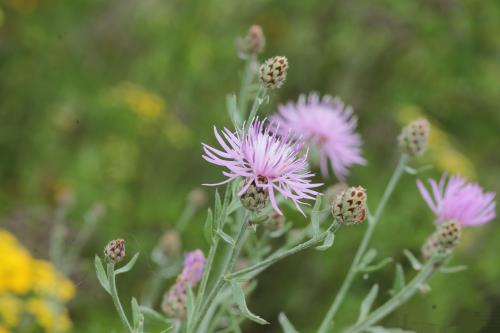
Spotted knapweed (Centaurea stoebe) releases a chemical through its roots that is toxic to other plants, allowing it to be a widespread invasive problem in Michigan. Photo by Rob Routledge, Sault College, Bugwood.org.
What is an invasive plant?
The federal government defines these plants as a non-native organism within a particular ecosystem whose introduction causes or is likely to cause economic or environmental harm, or harm to human, animal or plant health. Non-native plants—those reproducing outside of their natural ranges—are only invasive if they cause harm as described in the previous definition.
For example, oriental bittersweet, or Celastrus orbiculatus, is an invasive vine confirmed to be established in Michigan. It climbs and overtakes native trees and shrubs, including girdling trunks and branches. The dense vines weigh down tree canopies, causing limbs to break. The berries are pretty and this tempts people to grow and gather them despite their invasiveness.
Oriental bittersweet is similar to the native American bittersweet (Celastrus scandens), which is a protected species in Michigan. American bittersweet is rare and people are not likely to see it. It has elliptical leaves and its fruits and flowers clump together at the end of a branch. In contrast, oriental bittersweet’s leaves are rounded with fruits and flowers spreading out along the stem.
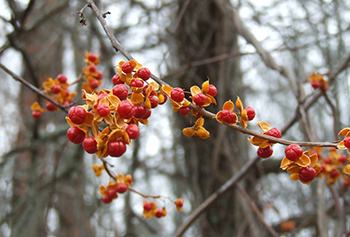
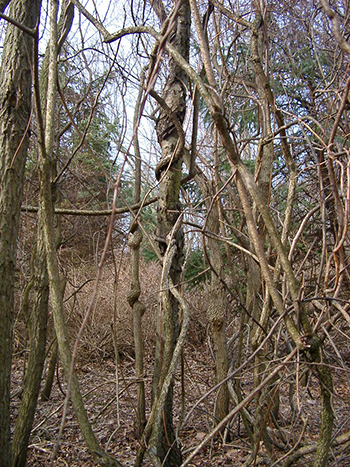
Oriental bittersweet berries (left/top) are attractive, but this invasive vine climbs native trees and shrubs, girdling trunks and branches (right/bottom). Photos by Rebecca Finneran, MSU Extension.
Invasive plant behavior
Invasive plants have growth and reproductive habits along with dispersal mechanisms that allow them to travel and take over new environments where they displace native and other less-aggressive plants. Factors of concern include:
- Rapid vegetative growth. Invasive plants grow significantly faster than their similar counterparts.
- High reproductive capacity. Invasive plants have abundant seed production and reproduction via fragments of roots or underground stems that quickly spread.
- Toxic chemical production. Invasive plants can leach compounds into the soil that harm desired plants or harm microbes that help other plants grow.
- Lack of natural predators. Many invasive species are thriving outside the range of natural predators that would normally control them.
Recognizing invasive plant species
See our resource list and do your own research into specific plants you are considering. Check the plant’s behavior for the concerns listed above, which could threaten nearby ecosystems. Armed with knowledge, you can AVOID obtaining and spreading invasive plant species.
Resources for dealing with invasive plants
- The State of Michigan has lists of invasive plants that are already established in Michigan or are on the watch list for being introduced and spreading in Michigan.
- Midwest Invasive Species Information Network (MISIN) for reporting infestations and training in identification. They have invasive species training modules that provide names and distinguishing characteristics of invasive plants.
- Michigan Natural Features Inventory (MNFI) and Michigan Department of Natural Resources (MDNR) Best Control Practice Guides.
- Smart Gardening tip sheets on native plants and mulch.
- For more information about avoiding potentially invasive landscape plants, contact your local MSU Extension consumer horticulture educator or call MSU Extension’s toll-free Lawn and Garden Hotline at 1-888-678-3464.
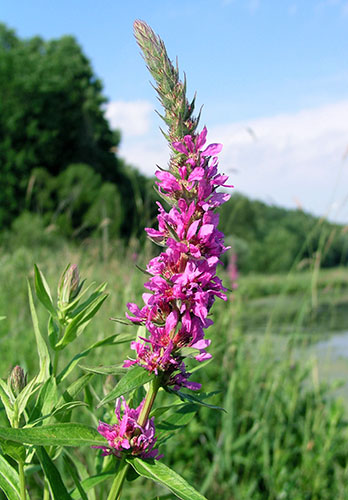
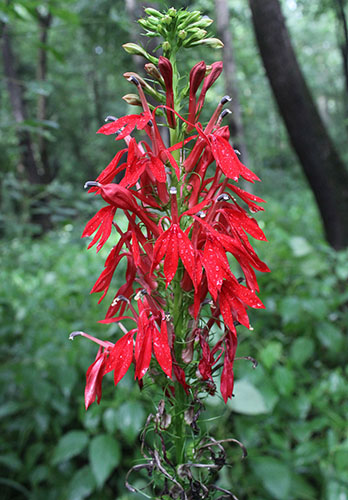
Left/top: The invasive wetland plant purple loosestrife (Lythrum salicaria) produces many seeds and its stems and roots break off easily to form new plants. Right/bottom: In contrast, the non-invasive cardinal flower (Lobelia cardinalis) has very small seeds, tender seedlings and a short life. Photos by Linda Wilson, University of Idaho, Bugwood.org (purple loosestrife) and Chris Evans, University of Illinois, Bugwood.org (cardinal flower).
Managing and disposing of invasive plants
Check the Best Control Practice Guides for species-specific steps to remove invasive plants. If complete removal is not possible, still do something! Small steps can reduce the spread of an invasive plant, even if complete removal is delayed or not possible.
General guidelines for managing invasive plants
- Remove flowers and seed heads before invasive plant seeds mature.
- Research the specific plant species to determine whether pruning or mowing will help control or spread it.
Sanitize tools and vehicles
- Carefully remove plant debris from recreational and other vehicles, such as lawn mowers and tractors.
- Remove plant debris from clothing, footwear and yard tools (rakes, forks, etc.) and properly dispose it.
Use proper disposal methods
Seeds and reproductive roots and stems from invasive plants can grow and spread from within waste piles.
- Do not add invasive plant remains to compost bins, scrap piles or natural areas.
- Where permitted, consider burning invasive plant parts. Note: Do not burn the toxic plant poison ivy with other plant waste, as some people will get an allergic reaction if they inhale the smoke or fumes.
- Double-bag invasive plant material in plastic bags and dispose in a certified landfill.
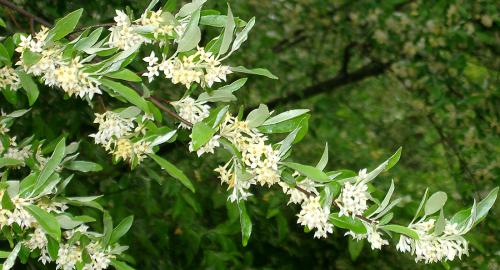
Invasive autumn oliveInvasive autumn olive (Elaeagnus umbellata Thunb.) in flower. Photo by Rebecca Finneran, MSU Extension.
Stop plants from invading
Replant disturbed or open areas quickly because invasive plants will move into open ground. Cover crops or mulch can be a good temporary solution.
Build variety into the landscape. A greater diversity of plants and microhabitats in the landscape means a greater chance desired plants will outcompete potential invaders, and a lesser chance that a large area of your yard is perfect for invasive plant growth. Consider including native plants to further increase diversity.
Act quickly. It is much easier to remove a small patch of invasive plant than a large one. Continue monitoring the area once it is removed. In many cases, conducting multiple control measures at the same time is effective.
For more information on a wide variety of smart gardening topics, visit the Gardening in Michigan website or call the MSU Extension Lawn and Garden Hotline at 1-888-678-3464.
This work is supported by the Crop Protection and Pest Management Program 2017-70006-27175 from the USDA National Institute of Food and Agriculture. Any opinions, findings, conclusions or recommendations expressed in this publication are those of the author(s) and do not necessarily reflect the view of the U.S. Department of Agriculture.



 Print
Print Email
Email





